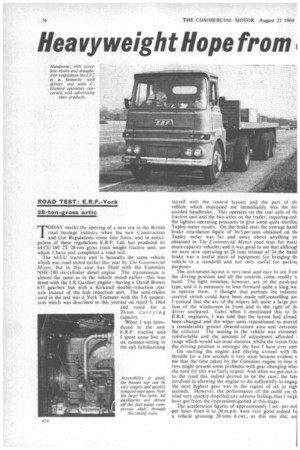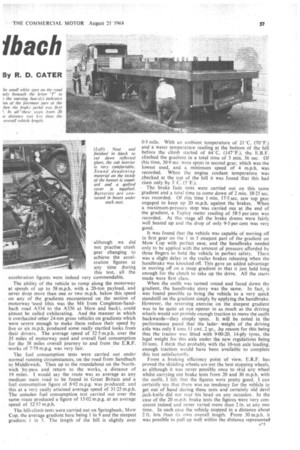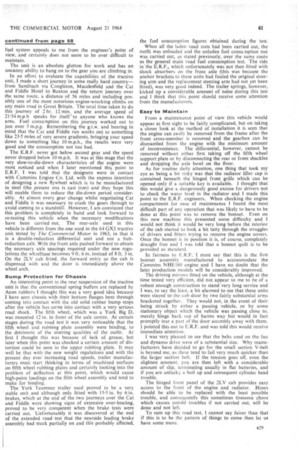Heavyweight Hope from Mach
Page 60

Page 61

Page 65

If you've noticed an error in this article please click here to report it so we can fix it.
By R. D. CATER
TODAY marks the opening of a new era in the British road haulage industry when the new Construction and Use Regulations come into force, and in anticipation of these regulations E.R.F. Ltd. has produced its 64 CU 180 2T 28-ton gross train weight tractive .unit, on which I have just completed a road test.
The 64 CU tractive unit is basically the same vehicle which was road tested earlier this year by The Commercial Motor, but in this case was fitted with the Cummins NHE-180 six-cylinder diesel engine. The transmission is almost the same as in the vehicle tested earlier --this was fitted with the LX Gardner engine—having a David Brown 657 gearbox but with a Kirkstall double-reduction rear axle instead of the hub reduction unit. The semi-trailer used in the test was a York Teamster with the TA suspension which was described in this journal on April 3, 1964 and rated for a 20-ton carrying capacity.
When I was introduced to the new E.R.F. tractive unit I spent some five or six minutes sitting in the cab familiarizing
myself with the control layout, and the part of th vehicle which impressed me immediately was the air assisted handbrake. This operates on the rear axle of th tractive unit and the two axles on the trailer, requiring onl: the lightest operating pressures to give some quite startlim Tapley meter results. On the brake tests the average hand brake retardation figure of 36.5 per cent obtained on th Tapley meter was far and away above anything ye obtained in The Commercial Motor road tests for maxi mum-capacity vehicles, and it was good to see that althougl we were now operating at 28 tons instead of 24 the hand brake was a useful piece of equipment for bringing thi vehicle to a standstill and not only useful for parkinl purposes.
The instrument layout is very neat and easy to see fron the driving position and all the controls come readily 6 hand. The light switches, however, are of the push-pul type, and it is necessary to lean forward quite a long wa; to operate them. I thought that perhaps the indicato control switch could have been made self-cancelling am I noticed that the arc of the wipers left quite a large por tion of the windscreen in front and to the right of th driver uncleared. Later when I mentioned this to th E.R.F. engineers, I was told that the layout had alread been changed and the wiper units repositioned to provid a considerably greater cleared-screen area and overcom the criticism The seating in the vehicle was extreme] comfortable and the amount of adjustment afforded range which would suit most statures, whilst the vision fron the driving position is amongst the best I have ever seer On starting the engine and playing around with th throttle for a few seconds it very soon became evident tl me that the time taken by the Cummins engine to lose it revs might present some problems with gear changing whel the need for this was fairly urgent. And when we got out 01 to the road this indeed proved to be the case; the tim involved in allowing the engine to die sufficiently to engag the next highest gear was in the region of six to eigh seconds. However, the performance of the outfit on th road very quickly dispelled any adverse feelings that I migh have got from the impressions_gained at this stage.
The acceleration figures of approximately 1 sec. per mi per hour from 0 to 20 m.p.h. were very good indeed f a vehicle grossing 28 tons 6 cwt., as this one did, an although we did not practise crash gear changing to achieve the acceleration figures at any time during this test, all the acceleration figures were indeed very commendable.
The ability of the vehicle to romp along the motorway at speeds of up to 58 m.p.h. with a 20-ton payload, and never drop more than one or two m.p.h. below this speed on any of the gradients encountered on the section of motorway used (this was the M6 from Congleton-Sandbach road A534 to the A556 at Mere and back), could almost, be called exhilarating. And the manner in which it overhauled other 24-ton gross vehicles on gradients which were severe enough to make them reduce their speed by five or six m.p.h. produced some really startled looks from their drivers. The average speed of 52.5 m.p.h. over the 35 miles of motorway used and overall fuel consumption for the 38 miles overall journey to and from the E.R.F. -works of 7-79 m.p.g. was very fair.
The fuel consumption tests were carried out under normal running circumstances, on the road from Sandbach to Middlewich. Then up to the roundabout on the Northwich by-pass and return to the works, a distance of 19 miles. I would say the route was as average as any medium main road to be found in Great Britain and a fuel consumption figure of 8.92 m.p.g. was produced; and this at a very easily attained average speed of 31-25 m.p.h. The unladen fuel consumption test carried out over the same route produced a figure of 15.02 m.p.g. at an average speed of 32.57 m.p.h.
The hill-climb tests were carried out on Springbank, Mow Cop, the average gradient here being 1 in 9 and the steepest gradient 1 in 5. The length of the hill is slightly over 0.5 mile. With an ambient temperature of 21`C. (70°F.) and a water temperature reading at the bottom of the hill before the climb started of 64`C. (147°F.), the E.R.F. climbed the gradient in a total time of 3 mm. 36 sec. Of this time, 30.9 sec. were spent in second gear, which was the lowest used, and a minimum speed of 4 m.p.h. was recorded. When the engine coolant temperature was checked at the top of the hill it was found that this had 'risen only by 3'C.
-• The brake fade tests were carried out on this same . gradient and a total time to come down of 2 min. 38.25 sec. was recorded. Of this time 1 min. 17.5 sec. saw top gear engaged to keep up 20 m.p.h. against the brakes. When a maximum-pressure stop was carried out at the end of the gradient, a Tapley meter reading of 58-5 per cent was recorded. At this stage all the brake drums were fairly • well heated up and the drop of only 9-5 per cent was very good.
It was found that the vehicle was capable of moving off in first gear on the 1 in 5 steepest part of the gradient on Mow Cop with perfect ease, and the handbrake needed only to be applied with the amount of pressure afforded by three fingers to hold the vehicle in perfect safety. There was a slight delay in the trailer brakes releasing when the handbrake was knocked off. This gave an added advantage in moving off on a steep gradient in that it just held long enough for the clutch to take up the drive. All the starts made were first class.
When the outfit was turned round and faced down the gradient, the handbrake story was the same. In fact, it
• was found possible to bring the vehicle to a very quick standstill on the gradient simply by applying the handbrake. However, the reversing exercise on the steepest gradient was to be quite an eye opener in as much as the driving wheels would not provide enough traction to move the outfit backwards—they simply spun.. It will be noted in the performance panel that the laden weight of the driving axle was only 8 tons I I cwt. 2 qr., he reason for this being that the tractor was fitted with 9.00-20, 14-ply tyres, the legal weight for this axle under the new regulations being 10 tons. I think that probably with the I0-ton axle loading. enough traction would have been 'available. to complete this test satisfactorily.
From a braking efficiency point of view, E.R.F. has proved the skidding wheels-are not the best stopping wheels. as although it was never possible once to skid any wheel whilst carrying out brake tests from 20 and 30 m.p.h. with the outfit,. I felt that the figures were pretty -good. I can certainly say that there Was no tendency for the vehicle to get out of hand during these tests and certainly old devil jack-knife did not rear his head on any occasion. In the case of the 20 m.p.h. brake tests the figures were very consistent indeed and never varied more than 2 in. at any one time. In each case the vehicle stopped in a distance about 2 ft. less than its own overall length. From 30 m.p.h. it was possible to pull up well within the distance represented fuel system appeals to me from the engineer's point of view, and certainly does not seem to be over difficult to maintain.
The unit is an absolute glutton for work and has an uncanny ability to hang on to the gear you are climbing in.
In an effort to evaluate the capabilities of the tractive unit, I made a short journey in some really hard country— from Sandbach via Congteton, Macclesfield and the Cat and Fiddle Hotel to Buxton and the return journey over the same route, a distance of 56 miles and including possibly one of the most notorious engine-wrecking climbs on any main road in Great Britain. The total time taken to do this journey of 2 hr. 12 min. and the average speed of 21.54 rn.p.h speaks for itself 'to anyone who knows the area. Fuel consumption on this journey worked out to just over 5 m.p.g. Remembering the g.t.w. and bearing in mind that the Cat and Fiddle run works out to something like 23.5 miles of very severe gradients, bringing your speed down to something like 10 m.p.h., the results were very good and the consumption not too bad.
The E.R.F. never got below second gear and the speed never dropped below 10 rn.p.h. It was at this stage that the very slow-to-die-down characteristics of the engine were most noticed and when I later mentioned this point to E.R.F. I was told that the designers were in contact with Currunins Engine Co. Ltd. with the express intention of designing a new flywheel which is to be manufactured in steel (the present one is cast iron) and they hope this will enable them to reduce the die-down period considerably. At almost every gear change whilst negotiating Cat and Fiddle it was necessary to crash the gears through to avoid coming to a standstill. However, I am convinced that this problem is completely in hand and look forward to re-testing this vehicle when the necessary modifications have been carried out. The rear-axle used in this vehicle is different from the one used in the 64 GX3 tractive unit tested by Tire Commercial Motor in 1963, in that it is a double-reduction differential unit and not a hubreduction axle. With the front axle pushed forward to obtain the necessary aXle spacings required under the new regulations the wh.elbase becomes 9 ft, 6 in. instead of 8 ft. 3 in. On the 2LV cab fitted, the forward entry to the cab is dispensed with and the door is immediately above the wheel arch.
Bump Protection for Chassis An interesting point in the rear suspension of the tractive unit is that the conventional spring buffers are replaced by Aeon rubbers 1 thought this was a very good idea because I have seen chassis with their bottom flanges bent through coming into contact with the old solid rubber bump stops after the vehicle has come into contact with a very serious road shock. The fifth wheel, which was a York Big D, was mounted 12 in. in front of the axle centre. At certain stages during the road test it was very noticeable that the fifth wheel and rubbing plate assembly were binding, to the detriment of the steering qualities of the outfit. At first I thought this was because of lack of grease, but later when this point was checked a certain amount of distortion could be seen in the upper rubbing plate. It may well be that with the new weight regulations and with the present day ever increasing road speeds, trailer manufacturers must Start thinking in terms of machined surfaces on fifth wheel rubbing plates and certainly looking into the problem of deflection at this point, -which would cause high-point loadings on the fifth wheel assembly and tend to make for binding.
The York Teamster trailer used proved to be a very stable unit and although only fitted with 15.5 in. by 6 in. brakes, which at the end of the two journeys over the Cat and Fiddle were showing signs of extensive over-heating, proved to be very competent when the brake tests were carried out.. Unfortunately it was discovered at the end of the extended road test that the nearside leading brake assembly had stuck partially on and this probably affected, the fuel consumption figures obtained during the test.
When all the laden road tests had been carried out, the outfit was unloaded and the unladen fuel consumption test was carried out, as stated previously, over the same route as the general main road fuel consumption test. The ride in the E.R.F., which unfortunately was not then fitted with shock absorbers on the front axle (this was because the anchor brackets to these units had fouled the original steering arm and the replacement steering arm had not yet been fitted), was very good indeed. The trailer springs, however, kicked up a considerable amount of noise during this test and I think that this point should receive some attention from the manufacturers.
Easy to Maintain
From a maintenance point of view this vehicle would appear at first sight to be fairly complicated, but on taking a closer look at the method of installation it is seen that the engine can easily be removed from the frame after the front cross-member is removed and the gearbox can be dismantled from the engine with the minimum amount of inconvenience. The differential, however, cannot be removed without either first taking off the •fifth wheel support plate or by disconnecting the rear or front shackles and dropping the axle bowl on the floor.
As for routine daily attention, one thing that took my eye as being a bit risky was that the radiator filler cap is contained beneath the hinged front grille which can be opened only if a suitable key is available. I thought that this would give a dangerously good excuse for drivers not to check the water level in the radiator and 1 made this point to the E.R.F. engineers. When checking the engine compartment for ease of maintenance I found the most difficult part of any operation that was likely to have to be done at this point was to remove the bonnet. Even on this new machine this presented some difficulty and I would not think it would be very long before the interior of the cab started to look a bit tatty through the struggles of drivers and fitters trying to remove the engine covers. Once the bonnet is in position it is, of course, completely draught free and I was told that a bonnet quilt is to be provided as standard.
In fairness to F.R.F. I must say that this is the first bonnet assembly manufactured to accommodate the Cummins NHE180 engine and I have no doubt that the later production models wit] be considerably improved.
The driving mirrors fitted on the vehicle, although at the time tested very efficient, did not appear to me to be of a robust enough construction to stand very long service and I was, to say the least, a bit alarmed to see that these units were stayed to the cab door by two fairly substantial arms bracketed together. They would not, in the event of their being struck by either a passing vehicle, or by some stationary object which the vehicle was passing close to, merely hinge back out of harms way but would in fact promptly tear a part of the door assembly away with them. 1 pointed this out to F.R.F. and was told this would receive immediate attention.
I was very pleased to see that the belts used on the fan and dynamo drive were of a substantial size. Why manufacturers have decided to go for the small section V-belt is beyond me, as these tend to fail very much quicker than the larger section belt. If the tension goes off, even the slightest amount, you are then left with a considerable amount of slip, terntinating usually in flat batteries, and if you are unlucky a boil up and consequent cylinder head trouble.
The hinged front panel of the 2LV cab provides easy access to the front of the engine and radiator. Hoses should be able to be replaced with the least possible trouble, and consequently this sometimes tiresome chore which causes untold troubles if not carried out, will be done and not left.
To sum up this road test, I cannot say fairer than that if this is to be the pattern of things to come then let us have some more.






















































































































